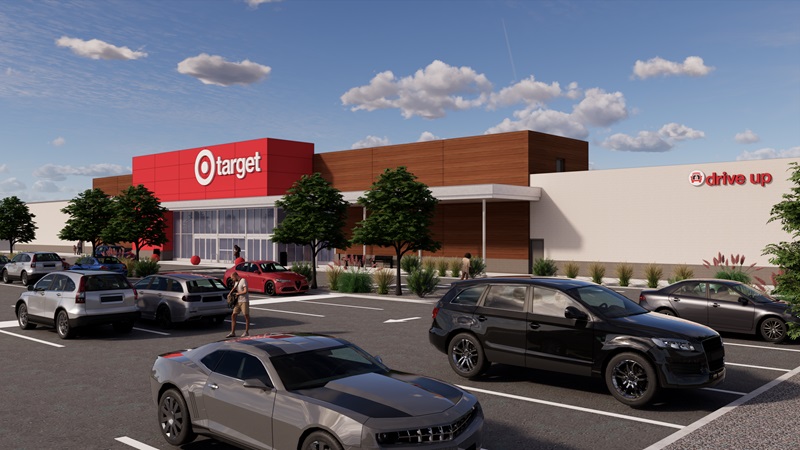Shopping
Expansion by grocers, big boxes spurring major updates of New Jersey shopping centers – Real Estate NJ

ShopRite is expanding and relocating within Watchung’s Blue Star Shopping Center on Route 22, prompting a $12 million update of the nearly 420,000-square-foot property, as seen in early June — Photos by Aaron Houston for Real Estate NJ
By Marlaina Cockcroft
As supermarkets and other anchor tenants look to expand their reach in New Jersey, landlords are accommodating them with renovated shopping centers that are likely to help attract new retailers to those properties.
The improvements are new, but the strategy is not, according to industry insiders. Repurposing buildings for anchor tenants by expanding their space and responding to customers’ changing tastes is necessary in a largely built-out state where new construction isn’t always an option.
“With the density of the population that we have in New Jersey, there is probably more redevelopment going on here than in other parts of the country where you may see new construction,” said Matthew K. Harding, CEO of Levin Management Corp., the North Plainfield-based firm that provides leasing, management and construction services to third-party clients.
Three of LMC’s current projects demonstrate this strategy. At Blue Star Shopping Center on Route 22 West in Watchung, a ShopRite operated by Village Supermarkets is moving from its existing 44,000-square-foot store to an adjacent 72,000-square-foot space that’s slated to be completed in summer 2025. The firm will renovate the original space for new tenants while making other improvements to the nearly 420,000-square-foot property, including new facades, lighting and landscaping as well as parking lot upgrades and the addition of outdoor seating and electric vehicle charging stations.
 Capital expenditures for the project, which is sprucing up the well-known, 65-year-old shopping center at 1701 Route 22, are estimated at $12 million, according to LMC.
Capital expenditures for the project, which is sprucing up the well-known, 65-year-old shopping center at 1701 Route 22, are estimated at $12 million, according to LMC.
Work is also underway at West Orange Plaza at 235 Prospect Ave. in West Orange, where LMC is expanding a former Kmart building to house a new Target by fall 2025. The firm, which is working on ownership’s behalf, is adding three buildings totaling around 38,000 square feet — with construction on the first two set to begin this summer and a targeted completion date in 2026. It’s also making parking improvements and updating the landscaping, lighting and signage, estimating that the total investment is around $15 million.
Harding said that, while the company has worked on other shopping center renovations or repurposing of big boxes, “what we’re seeing now is really some strong activity in terms of tenants such as Target and others looking to take limited spaces that are available in shopping centers these days and rebuilding, reinventing the property around them.” Another LMC-managed project, Flemington Marketplace in Flemington, will feature a new Target in addition to existing anchors Kohls and Aldi, along with updated lighting and landscaping.

Ed Turkot, senior vice president of Saker ShopRites, added: “Having a supermarket as an anchor gives an ability to attract tenants that you would otherwise not be able to attract, based on the foot traffic that you’re bringing into the location.” For instance, Saker recently relocated a ShopRite from Piscataway to a larger space in South Plainfield’s Hadley Center, and other tenants are expected to follow.
Stephen Hittman of Crossroads Cos., a development firm specializing in grocery-anchored retail projects, said companies have a financial incentive to repurpose shopping centers.

“I think there’s probably less speculation, because the cost has doubled — in some cases more than doubled — and I think the lending environment is more difficult,” said Hittman, CEO of the Mahwah-based firm. Banks require a greater down payment and interest rates are higher, which puts constraints on real estate development, he said.
At the Watchung and West Orange properties, LMC wants to attract tenants that reflect customers’ tastes as well as how they shop.
“The mix of tenants in open-air shopping centers has changed over time,” Harding said, from moderate-priced apparel chains to bigger ones like TJ Maxx and Burlington as well as medical offices, gyms and casual restaurants. LMC is negotiating with a variety of tenants but hasn’t signed leases yet, he added.
To account for the increase in online shopping, the loading docks at the Target in West Orange will be modified and there will be an in-store area for pickups and returns.
Matthew Casey, supermarket consultant and owner of Matthew P. Casey & Associates Inc. of Rahway, said dedicated pickup parking spots for online ordering and EV charging stations are catching on among larger tenants, typically as a means of staying competitive.
“I know most supermarkets hate online and home delivery,” he said. “Most of them don’t make money off of it. But since everybody does it, everybody has to do it,” given the rise in online ordering during the pandemic. Younger customers especially prefer to order online, he said.
Casey, who’s seen EV charging stations at the ShopRite in Columbia Park Center in North Bergen and at the Acme in Clark, said they can be placed in a little-used area of the lot and customers can shop while their car is charging.
“Not only does the tenant benefit, but the landlord is gathering newfound money,” he said.
Shopping center renovations may also reflect New Jersey’s increasingly competitive supermarket environment. Casey said that while ShopRite and Wegmans get the highest customer counts on an individual store basis, Lidl and Aldi are expanding across the East Coast and perform strongly on a dollar-per-square-foot basis. The competition prompts existing stores to remodel in order to retain market share.
“Retailers do have to reinvest and modernize their stores,” Harding said. “Store sizes change over time, store configurations change over time, you see retailers relocating.”
For instance, when Bed Bath & Beyond went out of business, many tenants took over those empty spaces because they were better located.
“It’s a trend that’s been going on over the decades, but it’s really very active now,” he said.
Marlaina Cockcroft is a freelance writer based in New Jersey. She has written for other publications including New Jersey Monthly and School Library Journal.








:max_bytes(150000):strip_icc()/roundup-writereditor-loved-deals-tout-f5de51f85de145b2b1eb99cdb7b6cb84.jpg)


